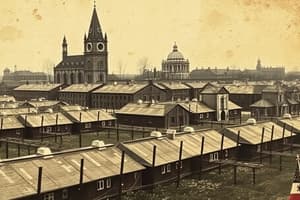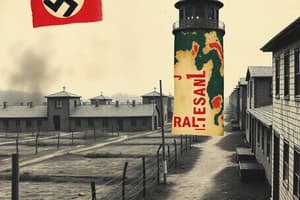Podcast
Questions and Answers
Which concentration camp was the first major Nazi camp to be liberated?
Which concentration camp was the first major Nazi camp to be liberated?
- Mauthausen
- Gross-Rosen
- Majdanek (correct)
- Auschwitz
The Soviet troops found no survivors upon entering the Auschwitz concentration camp.
The Soviet troops found no survivors upon entering the Auschwitz concentration camp.
False (B)
What was the name given to the forced marches of Auschwitz prisoners westward?
What was the name given to the forced marches of Auschwitz prisoners westward?
death marches
Upon liberating Auschwitz, the Soviet soldiers found hundreds of thousands of men's suits, more than 800,000 women's garments, and more than 14,000 pounds of ______.
Upon liberating Auschwitz, the Soviet soldiers found hundreds of thousands of men's suits, more than 800,000 women's garments, and more than 14,000 pounds of ______.
Match the concentration camps with their locations upon liberation:
Match the concentration camps with their locations upon liberation:
Which of the following best describes the state of Majdanek when Soviet troops arrived?
Which of the following best describes the state of Majdanek when Soviet troops arrived?
The liberation of Nazi concentration camps happened after Germany's surrender.
The liberation of Nazi concentration camps happened after Germany's surrender.
Flashcards
Majdanek
Majdanek
The first major Nazi camp to be liberated by Soviet forces in the summer of 1944, located in Lublin, Poland.
Auschwitz
Auschwitz
The largest Nazi killing center and concentration camp complex, liberated by Soviet troops on January 27, 1945.
Death Marches
Death Marches
In the weeks preceding the liberation of Auschwitz, Nazi camp personnel forced prisoners to march westward in a desperate attempt to escape Soviet forces. These marches resulted in the deaths of many prisoners due to exhaustion, hunger, and disease.
Additional Camps
Additional Camps
Signup and view all the flashcards
Liberation of Nazi Concentration Camps
Liberation of Nazi Concentration Camps
Signup and view all the flashcards
Impact of Liberation
Impact of Liberation
Signup and view all the flashcards
Prisoners at Majdanek
Prisoners at Majdanek
Signup and view all the flashcards
Evidence of Mass Murder
Evidence of Mass Murder
Signup and view all the flashcards
Study Notes
Liberation of Nazi Concentration Camps
- Majdanek, located in Lublin, Poland, was the first major camp liberated, in the summer of 1944. Soviet forces advanced westward as liberation occurred.
- Prior to liberation, the SS evacuated most prisoners and personnel to other camps, like Gross-Rosen, Auschwitz, and Mauthausen.
- Remaining personnel abandoned Majdanek hastily without dismantling it as Soviet troops approached on July 22-23, capturing it virtually intact.
- Captured prisoners included Soviet prisoners of war, and evidence of Nazi mass murder was present.
Auschwitz Liberation
- Auschwitz, a large killing center and concentration camp complex, was liberated on January 27, 1945, by Soviet troops.
- Before Soviet arrival, the camp's personnel forced most prisoners on "death marches" westward.
- Soviet soldiers found over 6,000 emaciated prisoners alive upon entering.
- Evidence of mass murder, including destroyed warehouses with personal belongings of victims (e.g., thousands of suits, garments, pounds of hair), was discovered.
Further Liberations
- Soviet units liberated additional camps in the Baltic states and Poland in the months following Auschwitz.
- Stutthof, Sachsenhausen, and Ravensbrück were liberated in the weeks leading up to Germany's May 1945 surrender.
Studying That Suits You
Use AI to generate personalized quizzes and flashcards to suit your learning preferences.
Description
Explore the critical events surrounding the liberation of Nazi concentration camps, focusing on Majdanek and Auschwitz. Learn about the tactics used by the SS, the experiences of the prisoners, and the evidence left behind as Soviet troops advanced. This quiz covers significant moments from the summer of 1944 to January 1945.




